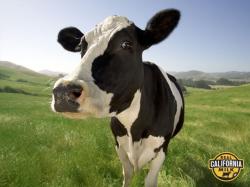U.N. Report: California Dairies Lead World With Lowest Carbon Footprint
April 28, 2010 | 3 min to read

SACRAMENTO – U.S. dairy farms, including California dairies, have the world’s lowest emissions of climate-changing “greenhouse gases,” according to a report released today by the United Nations.
American dairy farms emit about 45 percent fewer greenhouse gases per unit of milk produced compared to the global average for dairies, according to “Greenhouse Gas Emissions from the Dairy Sector – A Life Cycle Analysis,” published by the U.N.’s Food and Agriculture Organization (FAO). Note: The report and FAO news release can be found at http://www.fao.org/news/story/en/item/41348/icode/
“This is good news for consumers of California dairy products and California dairy farmers. It shows we’ve made tremendous progress reducing our carbon footprint, while also pointing the way for developing nations to do a better job,” said William C. Van Dam, chairman of Dairy Cares, a coalition of California dairy organizations dedicated to dairy sustainability issues.
Also according to the FAO report:
• Beef and milk production from the global dairy herd account for 4.1 percent of global greenhouse gas emissions:
o Milk production: 2.7 percent of GHGs o Beef from dairy cows and non-milk producing dairy calves: 1.3 percent
• Dairies in industrialized nations in North America, Europe and Australia/New Zealand had the lowest carbon footprint, with North America lowest of all. • Dairies in Central and South America and parts of Asia produce three to four times the carbon emissions of North American dairies, while dairies in sub-Saharan Africa produce up to 7 times more emissions. • While for dairies in industrialized nations, “methane emissions per kilogram of milk are relatively low,” the FAO said for dairies in developing nations, “marginal improvements of feed digestibility would achieve significant reductions in methane emissions per kg of milk.”
Van Dam noted that California dairy farmers have been particularly successful in achieving the production efficiencies cited in the FAO report.
“This is further evidence that California dairy families are leading the way on sustainability issues,” Van Dam said. “And while the U.S. is leading the world in production efficiency, we should also note that California dairies have been better than the average U.S. production efficiency for a number of years.”
A 2006 FAO report, “Livestock’s Long Shadow,” estimated that livestock production worldwide – including components such as clearing forests in developing nations for new agricultural land, growing crops for animals, fuel and transportation– is responsible for 18 percent of global greenhouse gas (GHG) emissions. Unfortunately, this information is sometimes misinterpreted to represent the role of dairy production rather than all livestock. Advocates of plant-based diets or vegan lifestyle have sometimes cited the “Long Shadow” report to inflate the role of dairy in climate change. Fortunately, the new FAO report adds new context to improve the understanding of where dairies fit in globally when it comes to climate change:
This new information in consistent with estimates previously established in the U.S., such as:
• U.S., dairies are estimated to produce less than 2 percent of the nation’s GHG emissions (Source: University of Arkansas Applied Sustainability Center). • California dairies (which produce one-fifth of the nation’s milk supply) are responsible for 2.3 percent of the state’s carbon greenhouse gas emissions (Source: California Air Resources Board).
How production efficiency works
Since 1944, thanks to improvements in breeding, cattle care, housing and nutrition, U.S. dairy farmers have reduced the carbon footprint of milk by 63 percent. In the same period, U.S. milk production increased by 59 percent, even as the total dairy cattle herd shrank from 25.6 million to 9.3 million cows.
Commitment to future progress
The U.S. dairy industry in 2009 announced additional measures to further reduce GHG emissions by 25 percent by 2020. Learn more at: www.usdairy.com/sustainability
Economic contribution
Besides providing one-fifth of our nation’s milk supply, affordable nutrition and food security for millions of Americans, California dairy families create 443,000 jobs statewide and $63 billion in economic activity.
What else can California consumers do to further reduce their carbon “foodprint”?
Support continued progress by purchasing California dairy products. This allows farm families here to continue to thrive and to invest in even better farming techniques, continuing progress toward a smaller carbon footprint and a more sustainable future.
Source: Dairy Cares
